Claas has just unveiled its new mid-sized range of combines known as the Trion series.
This marks the final stage in the total replacement of its combine range, which started with the introduction of the new generation Lexion 7000/8000 series combines in 2019.
Made up of 20 model variations, the new Trion range consists of five- and six-walker machines, single- and twin-rotor hybrids and most are available with Terra Tracs or the Montana hillside compensation system.
The new series is set to replace the entire Tucano line-up, with the exception of the 320, the entry model.
The Tucano range currently remains listed, but it is understood that it will be phased out in the near future.
The new range is aiming to bring about new performance standards on Claas mid-sized combines.
Some highlights include a new engine, a simpler drive and a new cab. The first of the new series (Trion 660 Terra Trac) is set to land in Ireland this week where it will begin its demo tour in Cork, before moving on to Tipperary and up through the country as the harvest progresses. 
The new Trion series is set to replace the entire Tucano line up with the exception of the 320, the entry model.
The range
The new series comprises of two 500-range five-straw walker machines, three 600 range six-straw walkers (including the Trion 640 which provides a new entry point into the six-straw walker market), and three 700-range hybrid models, of which two have a single rotor and one has twin rotors.
With Claas continuing to use its established threshing technology (APS system), the guts of the Trion walker and hybrid models will be familiar to previous-generation Lexion operators and owners.
Now also using the same width chassis as the new generation Lexions, the new Trion has helped Claas to streamline its manufacturing process by sharing the same assembly line.
The established APS primary threshing system is designed to thresh out up to 90% of grains, leaving the harder to thresh grains for the secondary separation system.
For greater throughput capacity on combines of this size, the Trion 500 and 700 range machines are fitted with a 1,420mm-wide threshing system, increasing to 1,700mm for Trion 600 models.
To put this into context, these are wider than the soon-to-be outgoing Tucano models, which were either 1,320mm or 1,580mm wide.
The Trion APS system comprises a 450mm-diameter accelerator and a 600mm-diameter closed threshing drum, which Claas says is 33% larger than the threshing drum on the outgoing Tucano.
This means the concave area is also greater, with the concave on 600 models being 31% larger than the Tucano 450, and the concave on Trion 700 models being 9% bigger than on the Tucano 580.
The front concaves are interchangeable and the speed of all three drums is synchronised and adjusted from the cab using Cebis, which is also used for adjusting the concaves (also synchronised).
With Claas continuing to use its established threshing technology (APS system), the guts of the Trion walker and hybrid models will be familiar to previous generation Lexion operators/owners.
Drive system
After standing back and taking a look at the workings of the drive, Claas opted to redesign the drive on the Trion and run with a simpler system.
There are now six fewer belts on hybrid models and three fewer on straw walker machines compared with the previous Tucano range.
Similar to the new-generation Lexion, the drive system is based on that used in the manufacturer’s Jaguar range of foragers, which is designed for a smoother engagement of the threshing and auger systems.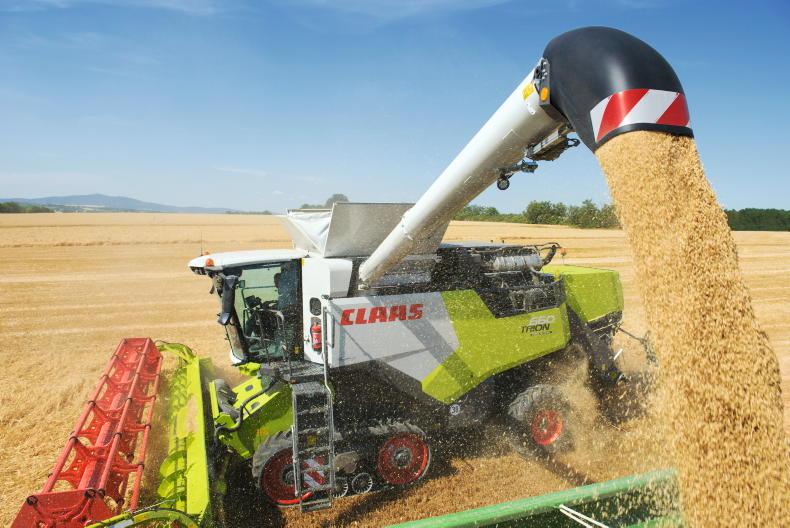
The Trion offers unloading rates ranging from 90 to 130 litres/second.
Secondary separation
All five- and six-straw walker 500 and 600 models will come as standard with the established Claas Multifinger Separation System (MSS), which evenly fluffs the straw for greater separation efficiency.
The manufacturer explained that the straw walkers use an open walker design and are 4.4m long with four steps.
The total separation area for 500 models is 6.25m2, rising to 7.48m2 for the Trion 600, which Claas claims is the largest of any combines of this size on the market.
The 720/730 hybrid models come with a single 4.2m-long and 570mm-diameter rotor with six grates, while the larger 750 model has twin 4.2m-long and 445mm-diameter rotors with five grates.
Claas has introduced hydraulic adjustment of four rotor flap ‘bomb doors’, with rotor speed infinitely adjusted independently of the APS system, a new feature for combines of this size.
All of the Trion range is set to feature the Jet Stream cleaning system using six or eight turbine fans.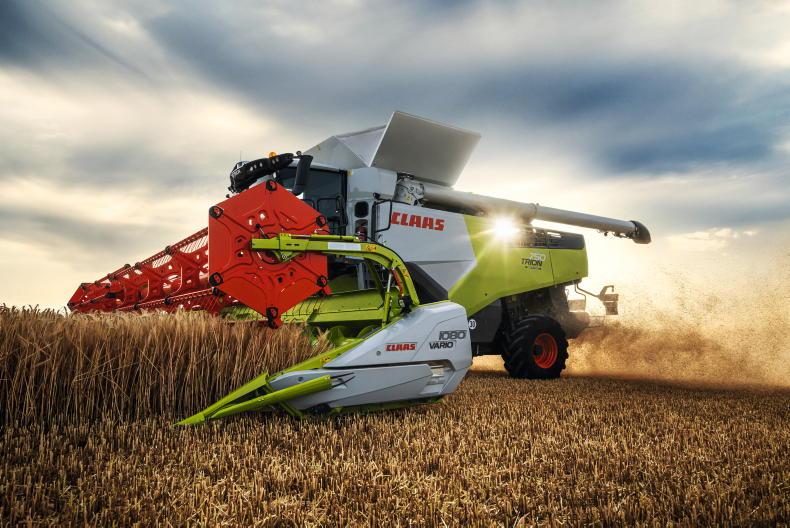
The new range can be used with the full range of Cerio or the new Vario range of auger type cutterbars, plus the Convio and Convio Flex draper type cutterbars.
Engine
The move to the Trion range sees Claas adopt the British-built 6.7l and 8.9l Cummins six-cylinder Stage V engines, which replace the outgoing Mercedes-Benz engines which were previously used in the Tucano range.
Claas envisages the Trion as a global machine, so it is understood that using an engine which has backup worldwide was an influencing factor.
This, combined with the fact the Cummins engine has the ideal weight and fits the combine size and layout, were all contributing factors according to the manufacturer.
As standard, all Trion models come with Dynamic Power. Claas says that by reducing engine power output when not under load, this can cut fuel costs by 10%. The rated engine speed in the field is 1,900 rpm, which drops to 1,650 for road travel. 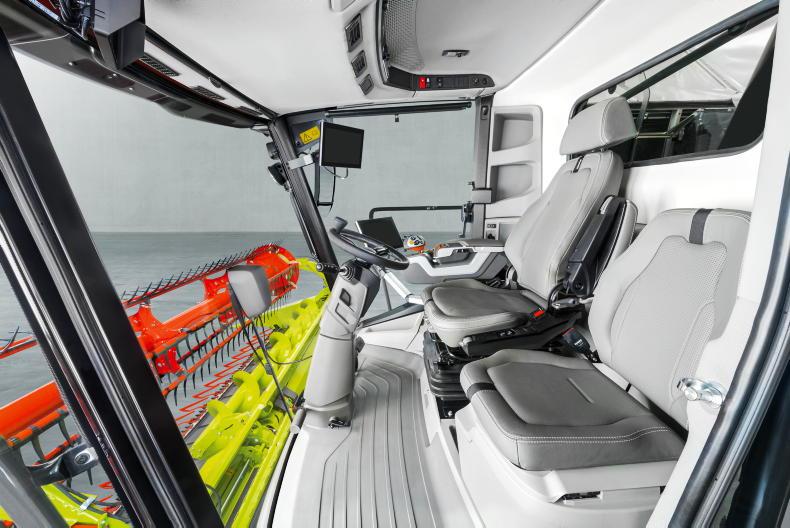
The revamped cab offers more leg and head room with a larger windscreen and narrower A-pillars.
Tracks
Six Trion models are available with either Terra Trac crawler tracks or the Montana hillside compensation system.
The Terra Trac system used for the Trion is similar to the third-generation system on the Lexion, with full suspension and a road speed of 30km/h. The track system is available on the five-straw walker Trion 530, making this the first Claas combine of this size to have the option.
The 530 also marks the starting point for the Montana slope compensation system (lateral slope compensation of up to 18%). All-wheel-drive is also an option on all Montana models.
With tank sizes ranging from 8,000l on the Trion 520 and up to 12,000l on the Trion 750, Claas claims to set a new standard for this size of combine.
Meanwhile, the unloading auger swings through 105° and offers unloading rates ranging from 90l to 130l/second.
The move to the Trion sees Claas adopt the British built 6.7 and 8.9 litre Cummins six-cylinder engines, which replace the outgoing Mercedes-Benz engines used in the Tucano range.
Cab
The revamped cab was designed to offer greater comfort and increased visibility. This was achieved through offering more leg and head room with a larger windscreen and narrower A-pillars.
As previously, in addition to using the 12in Cebis touchscreen, all the main combine functions can also be activated using buttons on the armrest.
Four automatic steering systems are available for the Trion: Laser Pilot on the cutterbar, the cab-mounted Field Scanner, Auto Pilot on maize headers or the satellite-based GPS Pilot, which is controlled using the new terminal.
Cutterbar options
The new range can be used with the full range of Cerio or the new Vario range of auger-type cutterbars, plus the Convio and Convio Flex draper-type cutterbars, in widths up to 12m.
As standard, it comes with automatic cutterbar detection, meaning the machine will always know what cutterbar is fitted and the setting previously used.
Meanwhile, at the rear of the machine, straw-chopper options range from a standard mechanically controlled chopper through to the advanced electronically controlled radial power spreader chopping system with deflectors for wind compensation. The standard chopping unit, (52 knives on Trion 700 and 400) and 64 knives (on the Trion 600), there is the option of the special cut chopper with 72 or 88 knives respectively.
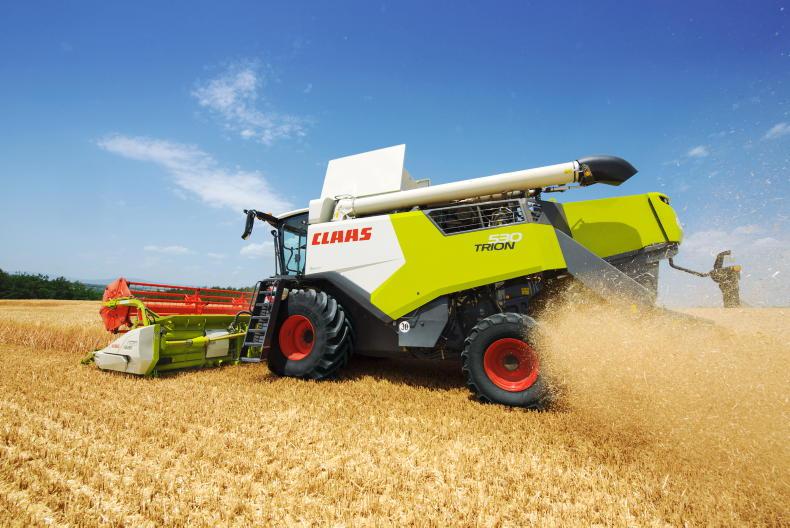
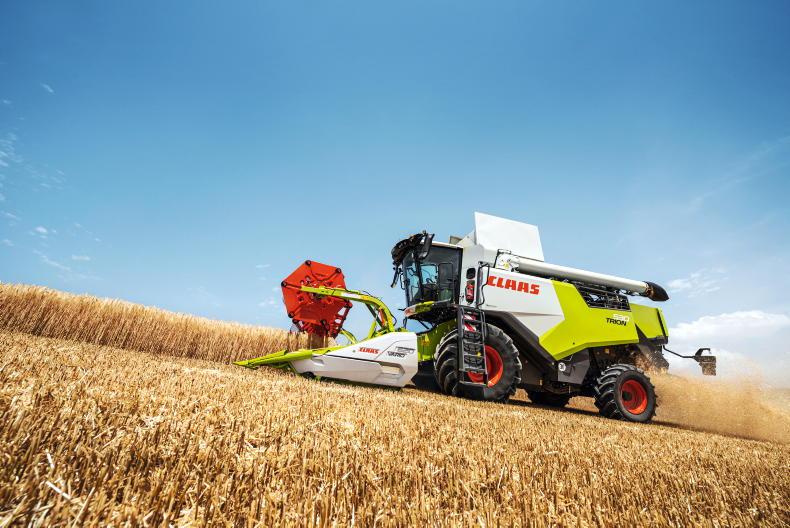
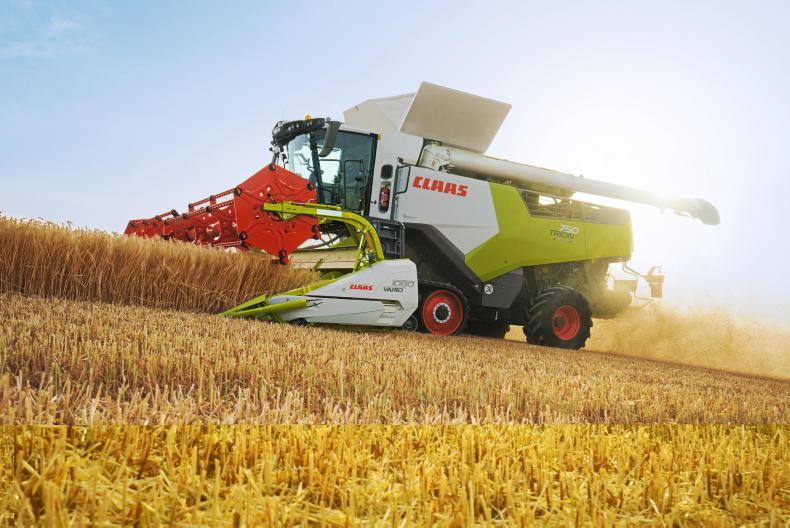

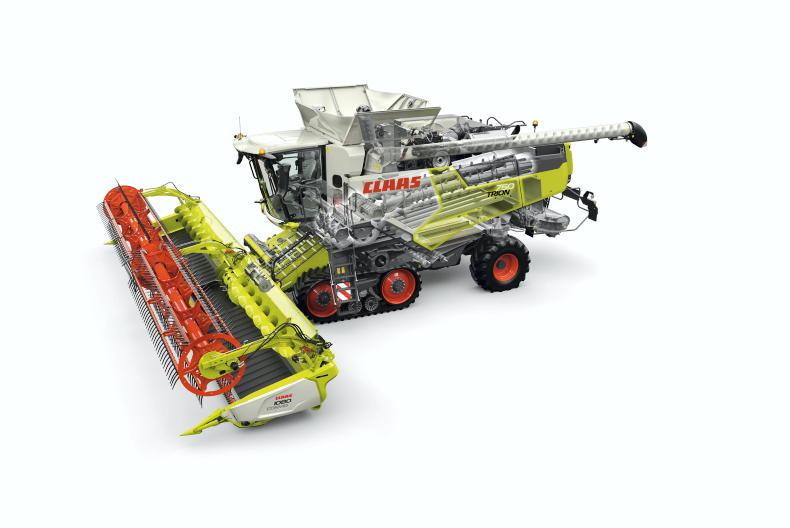
Claas has just unveiled its new mid-sized range of combines known as the Trion series.
This marks the final stage in the total replacement of its combine range, which started with the introduction of the new generation Lexion 7000/8000 series combines in 2019.
Made up of 20 model variations, the new Trion range consists of five- and six-walker machines, single- and twin-rotor hybrids and most are available with Terra Tracs or the Montana hillside compensation system.
The new series is set to replace the entire Tucano line-up, with the exception of the 320, the entry model.
The Tucano range currently remains listed, but it is understood that it will be phased out in the near future.
The new range is aiming to bring about new performance standards on Claas mid-sized combines.
Some highlights include a new engine, a simpler drive and a new cab. The first of the new series (Trion 660 Terra Trac) is set to land in Ireland this week where it will begin its demo tour in Cork, before moving on to Tipperary and up through the country as the harvest progresses. 
The new Trion series is set to replace the entire Tucano line up with the exception of the 320, the entry model.
The range
The new series comprises of two 500-range five-straw walker machines, three 600 range six-straw walkers (including the Trion 640 which provides a new entry point into the six-straw walker market), and three 700-range hybrid models, of which two have a single rotor and one has twin rotors.
With Claas continuing to use its established threshing technology (APS system), the guts of the Trion walker and hybrid models will be familiar to previous-generation Lexion operators and owners.
Now also using the same width chassis as the new generation Lexions, the new Trion has helped Claas to streamline its manufacturing process by sharing the same assembly line.
The established APS primary threshing system is designed to thresh out up to 90% of grains, leaving the harder to thresh grains for the secondary separation system.
For greater throughput capacity on combines of this size, the Trion 500 and 700 range machines are fitted with a 1,420mm-wide threshing system, increasing to 1,700mm for Trion 600 models.
To put this into context, these are wider than the soon-to-be outgoing Tucano models, which were either 1,320mm or 1,580mm wide.
The Trion APS system comprises a 450mm-diameter accelerator and a 600mm-diameter closed threshing drum, which Claas says is 33% larger than the threshing drum on the outgoing Tucano.
This means the concave area is also greater, with the concave on 600 models being 31% larger than the Tucano 450, and the concave on Trion 700 models being 9% bigger than on the Tucano 580.
The front concaves are interchangeable and the speed of all three drums is synchronised and adjusted from the cab using Cebis, which is also used for adjusting the concaves (also synchronised).
With Claas continuing to use its established threshing technology (APS system), the guts of the Trion walker and hybrid models will be familiar to previous generation Lexion operators/owners.
Drive system
After standing back and taking a look at the workings of the drive, Claas opted to redesign the drive on the Trion and run with a simpler system.
There are now six fewer belts on hybrid models and three fewer on straw walker machines compared with the previous Tucano range.
Similar to the new-generation Lexion, the drive system is based on that used in the manufacturer’s Jaguar range of foragers, which is designed for a smoother engagement of the threshing and auger systems.
The Trion offers unloading rates ranging from 90 to 130 litres/second.
Secondary separation
All five- and six-straw walker 500 and 600 models will come as standard with the established Claas Multifinger Separation System (MSS), which evenly fluffs the straw for greater separation efficiency.
The manufacturer explained that the straw walkers use an open walker design and are 4.4m long with four steps.
The total separation area for 500 models is 6.25m2, rising to 7.48m2 for the Trion 600, which Claas claims is the largest of any combines of this size on the market.
The 720/730 hybrid models come with a single 4.2m-long and 570mm-diameter rotor with six grates, while the larger 750 model has twin 4.2m-long and 445mm-diameter rotors with five grates.
Claas has introduced hydraulic adjustment of four rotor flap ‘bomb doors’, with rotor speed infinitely adjusted independently of the APS system, a new feature for combines of this size.
All of the Trion range is set to feature the Jet Stream cleaning system using six or eight turbine fans.
The new range can be used with the full range of Cerio or the new Vario range of auger type cutterbars, plus the Convio and Convio Flex draper type cutterbars.
Engine
The move to the Trion range sees Claas adopt the British-built 6.7l and 8.9l Cummins six-cylinder Stage V engines, which replace the outgoing Mercedes-Benz engines which were previously used in the Tucano range.
Claas envisages the Trion as a global machine, so it is understood that using an engine which has backup worldwide was an influencing factor.
This, combined with the fact the Cummins engine has the ideal weight and fits the combine size and layout, were all contributing factors according to the manufacturer.
As standard, all Trion models come with Dynamic Power. Claas says that by reducing engine power output when not under load, this can cut fuel costs by 10%. The rated engine speed in the field is 1,900 rpm, which drops to 1,650 for road travel. 
The revamped cab offers more leg and head room with a larger windscreen and narrower A-pillars.
Tracks
Six Trion models are available with either Terra Trac crawler tracks or the Montana hillside compensation system.
The Terra Trac system used for the Trion is similar to the third-generation system on the Lexion, with full suspension and a road speed of 30km/h. The track system is available on the five-straw walker Trion 530, making this the first Claas combine of this size to have the option.
The 530 also marks the starting point for the Montana slope compensation system (lateral slope compensation of up to 18%). All-wheel-drive is also an option on all Montana models.
With tank sizes ranging from 8,000l on the Trion 520 and up to 12,000l on the Trion 750, Claas claims to set a new standard for this size of combine.
Meanwhile, the unloading auger swings through 105° and offers unloading rates ranging from 90l to 130l/second.
The move to the Trion sees Claas adopt the British built 6.7 and 8.9 litre Cummins six-cylinder engines, which replace the outgoing Mercedes-Benz engines used in the Tucano range.
Cab
The revamped cab was designed to offer greater comfort and increased visibility. This was achieved through offering more leg and head room with a larger windscreen and narrower A-pillars.
As previously, in addition to using the 12in Cebis touchscreen, all the main combine functions can also be activated using buttons on the armrest.
Four automatic steering systems are available for the Trion: Laser Pilot on the cutterbar, the cab-mounted Field Scanner, Auto Pilot on maize headers or the satellite-based GPS Pilot, which is controlled using the new terminal.
Cutterbar options
The new range can be used with the full range of Cerio or the new Vario range of auger-type cutterbars, plus the Convio and Convio Flex draper-type cutterbars, in widths up to 12m.
As standard, it comes with automatic cutterbar detection, meaning the machine will always know what cutterbar is fitted and the setting previously used.
Meanwhile, at the rear of the machine, straw-chopper options range from a standard mechanically controlled chopper through to the advanced electronically controlled radial power spreader chopping system with deflectors for wind compensation. The standard chopping unit, (52 knives on Trion 700 and 400) and 64 knives (on the Trion 600), there is the option of the special cut chopper with 72 or 88 knives respectively.























 This is a subscriber-only article
This is a subscriber-only article





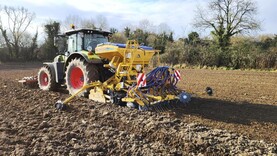
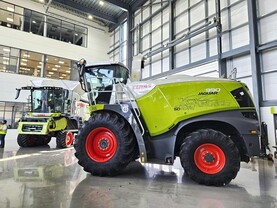
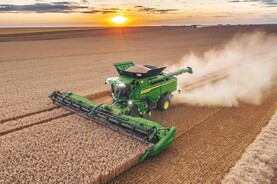
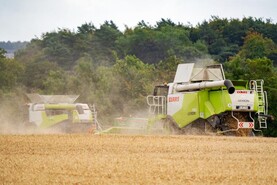
SHARING OPTIONS: